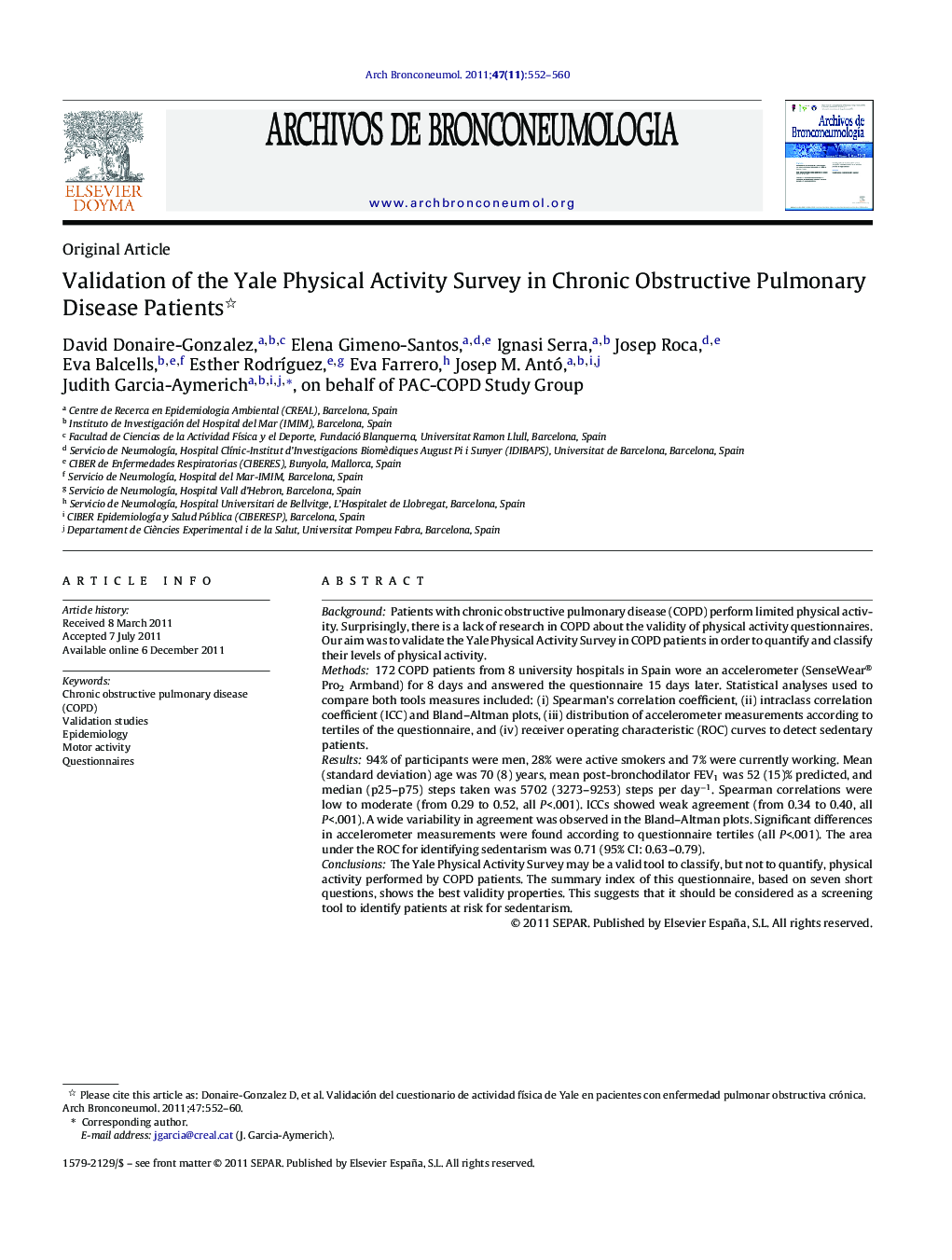| Article ID | Journal | Published Year | Pages | File Type |
|---|---|---|---|---|
| 4205802 | Archivos de Bronconeumología (English Edition) | 2011 | 9 Pages |
BackgroundPatients with chronic obstructive pulmonary disease (COPD) perform limited physical activity. Surprisingly, there is a lack of research in COPD about the validity of physical activity questionnaires. Our aim was to validate the Yale Physical Activity Survey in COPD patients in order to quantify and classify their levels of physical activity.Methods172 COPD patients from 8 university hospitals in Spain wore an accelerometer (SenseWear® Pro2 Armband) for 8 days and answered the questionnaire 15 days later. Statistical analyses used to compare both tools measures included: (i) Spearman's correlation coefficient, (ii) intraclass correlation coefficient (ICC) and Bland–Altman plots, (iii) distribution of accelerometer measurements according to tertiles of the questionnaire, and (iv) receiver operating characteristic (ROC) curves to detect sedentary patients.Results94% of participants were men, 28% were active smokers and 7% were currently working. Mean (standard deviation) age was 70 (8) years, mean post-bronchodilator FEV1 was 52 (15)% predicted, and median (p25–p75) steps taken was 5702 (3273–9253) steps per day−1. Spearman correlations were low to moderate (from 0.29 to 0.52, all P<.001). ICCs showed weak agreement (from 0.34 to 0.40, all P<.001). A wide variability in agreement was observed in the Bland–Altman plots. Significant differences in accelerometer measurements were found according to questionnaire tertiles (all P<.001). The area under the ROC for identifying sedentarism was 0.71 (95% CI: 0.63–0.79).ConclusionsThe Yale Physical Activity Survey may be a valid tool to classify, but not to quantify, physical activity performed by COPD patients. The summary index of this questionnaire, based on seven short questions, shows the best validity properties. This suggests that it should be considered as a screening tool to identify patients at risk for sedentarism.
ResumenIntroducciónLos pacientes con enfermedad pulmonar obstructiva crónica (EPOC) se caracterizan por una actividad física limitada. Sorprendentemente, apenas se dispone de investigación sobre los cuestionarios para medir la actividad física en la EPOC. El objetivo del presente estudio fue validar el cuestionario Yale Physical Activity Survey en pacientes con EPOC.MétodosUn total de 172 pacientes de 8 hospitales universitarios españoles usaron un acelerómetro (SenseWear® PrO2 Armband) durante 8 días y contestaron el cuestionario. Los análisis estadísticos de comparación de ambos instrumentos incluyeron: a) correlación de Spearman; b) coeficiente de correlación intraclase (CCI) y gráficos de Bland–Altman; c) distribución de las medidas del acelerómetro según los terciles del cuestionario, y d) la curva receiver operating characteristic (ROC) para detectar a los pacientes sedentarios.ResultadosEl 94% de los participantes eran hombres, el 28% eran fumadores y el 7% eran trabajadores activos; la edad media (±DE) fue de 70 (8) años, el volumen espiratorio medio en el primer segundo (VEMS) posbroncodilatador fue de 52 (15) como porcentaje del valor de referencia, y la mediana (p25–p75) de pasos fue de 5.702 (3.273–9.253) pasos/día. Las correlaciones de Spearman fueron débiles o moderadas (desde 0,29 hasta 0,52, todas las p < 0,001). Los CCI mostraron concordancias débiles (desde 0,34 hasta 0,40, todas las p < 0,001). Los gráficos de Bland–Altman mostraron una gran variabilidad en la concordancia. Se encontraron diferencias significativas en las medidas del acelerómetro según los terciles del cuestionario (todas las p < 0,001). El área bajo la curva ROC para identificar el sedentarismo fue de 0,71 (intervalo de confianza del 95%: 0,63–0,79).ConclusiónEl cuestionario Yale Physical Activity Survey es una herramienta válida para clasificar la actividad física que realizan los pacientes con EPOC, pero no para cuantificarla. El índice resumen del cuestionario, originado de tan solo 7 preguntas, muestra los mejores resultados de validez, sugiriendo que debería considerarse un instrumento de cribado para identificar a los pacientes que corren riesgo de sedentarismo.
